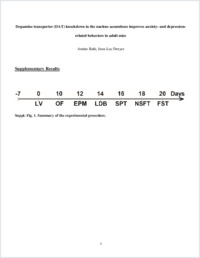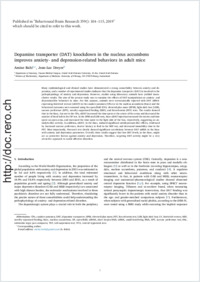Dopamine transporter (DAT) knockdown in the nucleus accumbens improves anxiety- and depression-related behaviors in adult mice
- Bahi, Amine Department of Anatomy, Tawam Medical Campus, United Arab Emirates University, Al Ain, United Arab Emirates
- Dreyer, Jean-Luc Division of Biochemistry, Department of Medicine, University of Fribourg, Switzerland
-
01.02.2019
Published in:
- Behavioural Brain Research. - 2019, vol. 359, p. 104–115
English
Many epidemiological and clinical studies have demonstrated a strong comorbidity between anxiety and depression, and a number of experimental studies indicates that the dopamine transporter (DAT) is involved in the pathophysiology of anxiety and depression. However, studies using laboratory animals have yielded inconclusive results. The aim of the present study was to examine the effects of DAT manipulation on anxiety- and depression-like behaviors in mice. For this purpose, animals were stereotaxically injected with DAT siRNA-expressing lentiviral vectors (siDAT) in the caudate putamen (CPu) or in the nucleus accumbens (Nacc) and the behavioral outcomes were assessed using the open-field (OF), elevated-plus maze (EPM), light- dark box (LDB), sucrose preference (SPT), novelty suppressed feeding (NSF), and forced-swim (FST) tests. The results showed that in the Nacc, but not in the CPu, siDAT increased the time spent at the center of the arena and decreased the number of fecal boli in the OF test. In the EPM and LDB tests, Nacc siDAT injection increased the entries and time spent on open arms, and increased the time spent in the light side of the box, respectively, suggesting an anxiolytic-like activity. In addition, siDAT, in the Nacc, induced significant antidepressant-like effects, evidenced by increased sucrose preference, shorter latency to feed in the NSF test, and decreased immobility time in the FST. Most importantly, Pearson’s test clearly showed significant correlations between DAT mRNA in the Nacc with anxiety and depression parameters. Overall, these results suggest that low DAT levels, in the Nacc, might act as protective factors against anxiety and depression. Therefore, targeting DAT activity might be a very attractive approach to tackle affective disorders.
- Faculty
- Faculté des sciences et de médecine
- Department
- Département de Médecine
- Language
-
- English
- Classification
- Biological sciences
- License
-
License undefined
- Identifiers
-
- RERO DOC 324099
- DOI 10.1016/j.bbr.2018.10.028
- Persistent URL
- https://folia.unifr.ch/unifr/documents/307490
Other files
Statistics
Document views: 112
File downloads:
- Supplementary material: 134
- pdf: 387

